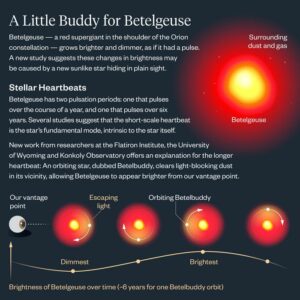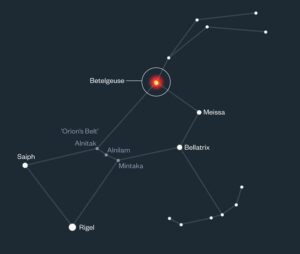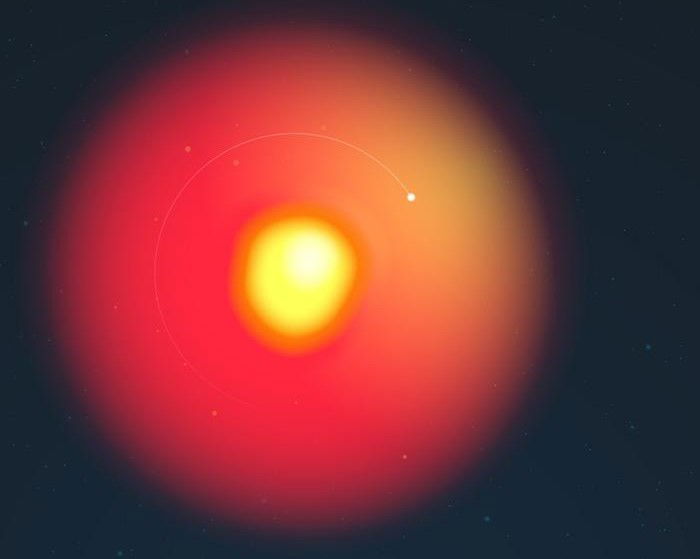New research has revealed that the star Betelgeuse is likely sharing its orbit with a companion astronomers have nicknamed “Betelbuddy.”
According to the new findings, unexpected dips in the star’s brightness observed in 2019 caused some scientists to speculate Betelgeuse may soon enter its supernova phase. As a result, media outlets quickly dubbed the tenth brightest star in the sky the doomed star.
Now, an international team of scientists says they’ve ruled out all conventional explanations for the star’s change in brightness, a phenomenon witnessed by observers dating back millennia, including a pending stellar explosion. This analysis left them with the likelihood a companion star is periodically acting like a “snowplow” and clearing light-blocking dust in Betelgeuse’s orbit, resulting in the observed changes in brightness.
“We ruled out every intrinsic source of variability that we could think of as to why the brightening and dimming was happening in this way,” said astrophysicist Jared Goldberg, the study’s lead author and a Flatiron research fellow at the Flatiron Institute’s Center for Computational Astrophysics. “The only hypothesis that seemed to fit is that Betelgeuse has a companion.”
Betelbuddy Theory Fits Observational Data of Betelgeuse
Ancient Chinese astronomers first noticed Betelgeuse’s periodic changes in brightness as far back as 200 BC, or three centuries before the Ancient Greek scientist Ptolemy described the star’s orange-tawny color and astronomical position. According to a 2017 study, Aboriginal Australians have told stories about the star’s changes in brightness for over 1,000 years. Notably, the Chinese astronomers described the star as yellow, leading modern researchers to consider whether it was going through a different phase then.
Most modern discussions of the star’s variable brightness began in the early 21st century when astronomers noticed an unusually pronounced dimming coming from Betelgeuse. The exact cause of this dimming has yet to be determined. Some theories suggest the elderly star, which is challenging to place but is likely around 724 light-years away from Earth in the constellation Orion, is nearing its death and preparing to go supernova. However, most scientists believe the changes are caused by something outside of the star itself.
To determine which explanation is most likely, Goldberg and colleagues Meridith Joyce of the University of Wyoming and László Molnár of Konkoly Observatory at the HUN-REN Research Centre for Astronomy and Earth Sciences in Hungary turned to computer simulations designed to approximate stellar phenomena. They combined observational data on Betelgeuse taken by conventional telescopes with simulations of the star’s activity and watched what happened.


One by one, the various possibilities fell away, leaving the researchers with just one option. An impending stellar explosion wasn’t causing the star’s brightness. Instead, the changes in luminosity were most likely the result of a companion Betelbuddy star clearing away dust surrounding its orbit. This clearing allowed more of the star’s light to reach Earth, resulting in the dimming and brightening cycles observed for millennia.
“Nothing else added up,” Goldberg said. “Basically, if there’s no Betelbuddy, then that means there’s something way weirder going on — something impossible to explain with current physics.”
Exotic Hypotheses for Star’s Changes in Brightness
While Betelgeuse is likely 14 times more massive than our Sun, the team’s simulations indicate that the star’s Betelbuddy may be only one or two times larger. According to Joyce, their data is insufficient, and at this time, they can only provide constraints for the theoretical star’s mass and orbit.
“A sunlike star is the most probable type of companion,” she said, “but that is by no means conclusive.”
While science fiction enthusiasts may posit far-fetched ideas like an orbiting space station or even a partial Dyson Sphere to explain Betelgeuse’s changes in brightness, one of the scientists who conducted the study says they have their preferred speculative hypothesis.
“A more exotic hypothesis I personally like, though the opinions of my co-authors may differ, is that the companion is a neutron star — the core of a star that has already gone supernova,” Joyce said. If correct, the researcher says they would detect X-rays in at least some of their observations, something they haven’t seen.
“I think we should look again,” Joyce added.


Discovering a Sunlike Star Hiding in Plain Sight
In the study’s conclusion, the authors note that their work involved simulations and that direct observations of Betelbuddy will be necessary to confirm its existence.
“We need to confirm that Betelbuddy actually exists since our result is based on inference, not on direct detection,” said Molnár. “So we’re working on observation proposals now.”
Fortunately, the team says there will be a potential “window of visibility” around December 6th of this year. If correct, they hope to take a picture of Betelbuddy with several telescopes and study it in more detail. Still, the team says their models offer compelling evidence, which may result in the discovery that Betelgeuse may not be domed after all.
“[Betelgeuse] has been the target of countless studies since the dawn of modern astrophysics,” said Molnár. “And yet there’s still room to make significant new discoveries: in this case, a sunlike star hiding in plain sight, in the immense glare of a red supergiant. That is what excites me the most.”
The study “A Buddy for Betelgeuse: Binarity as the Origin of the Long Secondary Period in α Orionis” has been accepted for publication in the Astrophysical Journal.
Christopher Plain is a Science Fiction and Fantasy novelist and Head Science Writer at The Debrief. Follow and connect with him on X, learn about his books at plainfiction.com, or email him directly at christopher@thedebrief.org.

